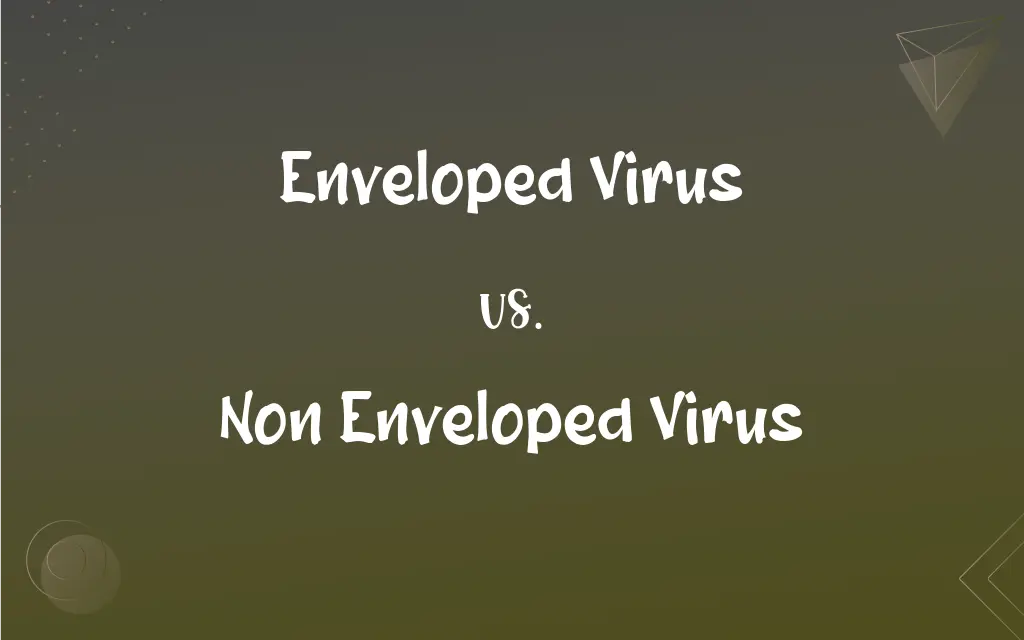Enveloped Virus vs. Non Enveloped Virus: What's the Difference?
Edited by Aimie Carlson || By Harlon Moss || Updated on October 6, 2023
Enveloped viruses have a lipid membrane covering their protein coat, while non-enveloped viruses lack this membrane.

Key Differences
An enveloped virus is distinguished by the presence of an outer lipid membrane, usually derived from the host cell's membrane, which surrounds its protein coat or capsid. This lipid envelope can play a role in the virus's ability to infect host cells. In contrast, a non-enveloped virus lacks this lipid covering and is made up solely of its nucleic acid content and protein coat.
The lipid envelope of an enveloped virus often contains viral proteins that aid in the process of entering host cells. This membrane can merge with host cell membranes, facilitating the viral entry. Non-enveloped viruses, on the other hand, employ different mechanisms to penetrate host cells, often by disrupting the host cell's plasma membrane or being taken up by endocytosis.
When it comes to environmental resilience, enveloped viruses are generally more sensitive to disinfectants, drying, and changes in temperature. Their lipid layer can be disrupted, rendering them non-infectious. Non-enveloped viruses, however, tend to be more resistant to these factors, making them harder to inactivate in external environments.
The presence or absence of an envelope can influence a virus's mode of transmission. Enveloped viruses, for instance, are commonly spread via respiratory droplets, as the lipid layer can help protect the virus in moist environments. Non-enveloped viruses often find their way through routes like the fecal-oral pathway, given their ability to endure harsher conditions such as the acidic environment of the stomach.
In terms of the immune response, enveloped viruses can sometimes evade the host's immune system due to their lipid covering, which can resemble host molecules. Yet, once this defense is breached, the immune system can effectively target them. Non-enveloped viruses, without this layer of camouflage, might be recognized more readily, but they present other challenges in terms of immune evasion.
ADVERTISEMENT
Comparison Chart
Lipid Membrane
Present
Absent
Environmental Resilience
Sensitive to disinfectants and drying
Resistant to disinfectants and drying
Mode of Transmission
Often respiratory droplets
Commonly fecal-oral or direct contact
Infection Mechanism
Merges with host cell membranes
Disrupts host cell membrane or uses endocytosis
Immune Evasion
Can mimic host molecules
Directly recognized but has other evasion techniques
ADVERTISEMENT
Enveloped Virus and Non Enveloped Virus Definitions
Enveloped Virus
A virus with an outer covering that can merge with host cells.
The enveloped virus herpes simplex causes cold sores.
Non Enveloped Virus
A microorganism enduring acidic and drying conditions due to its absence of a lipid layer.
The non-enveloped virus adenovirus can cause conjunctivitis.
Enveloped Virus
A microorganism with a lipid envelope enhancing its survival in moist environments.
The enveloped virus causing chickenpox spreads through respiratory droplets.
Non Enveloped Virus
A pathogen with a robust protein shell facilitating its survival in external environments.
HPV is a non-enveloped virus linked to warts and certain cancers.
Enveloped Virus
A virus surrounded by a lipid membrane derived from the host cell.
Influenza is an example of an enveloped virus.
Non Enveloped Virus
A virus that directly interacts with host cells without a lipid interface.
The non-enveloped virus poliovirus can lead to paralysis in severe cases.
Enveloped Virus
A viral particle protected by a lipid layer aiding in infection.
HIV, an enveloped virus, spreads through bodily fluids.
Non Enveloped Virus
A viral particle resistant to harsher external conditions.
Norovirus, a non-enveloped virus, causes stomach flu.
Enveloped Virus
A pathogen with a distinguishing lipid layer facilitating immune evasion.
Coronaviruses are enveloped viruses that can lead to respiratory illnesses.
Non Enveloped Virus
A virus lacking a lipid membrane and composed solely of a protein coat.
The common cold can be caused by a non-enveloped virus named rhinovirus.
FAQs
Which type of virus, enveloped or non-enveloped, merges with host cell membranes?
Enveloped viruses often merge with host cell membranes.
How do non-enveloped viruses typically enter host cells?
They often disrupt the host cell's membrane or are taken up by endocytosis.
Can enveloped viruses evade the immune system?
Enveloped viruses can sometimes evade initial immune recognition due to their lipid covering.
Which type of virus is more sensitive to soap?
Enveloped viruses are more sensitive, as soap can disrupt their lipid membrane.
Are enveloped viruses more sensitive to environmental factors?
Yes, enveloped viruses are generally more sensitive to disinfectants, drying, and temperature changes.
How are many non-enveloped viruses transmitted?
They are often spread through routes like fecal-oral transmission.
Which type of virus is more likely to mutate rapidly?
Both can mutate, but the lipid envelope of enveloped viruses can add a layer of complexity.
How do enveloped viruses obtain their lipid membrane?
They derive it from the host cell during the budding process.
Which type of virus is often spread via respiratory droplets?
Enveloped viruses are commonly spread this way.
Why do enveloped viruses have a lipid layer?
The lipid layer, derived from the host cell, aids in infection and can offer some protection to the virus.
Are non-enveloped viruses more stable in the environment?
Generally, yes. They tend to be more resistant to disinfectants and environmental changes.
Does the presence of a lipid envelope impact a virus's survival in moist environments?
Yes, enveloped viruses typically survive better in moist environments.
Can the lipid envelope of an enveloped virus be recognized by the immune system?
Yes, especially if it contains viral proteins that the immune system can target.
What is the main characteristic of an enveloped virus?
An enveloped virus has a lipid membrane surrounding its protein coat.
How do non-enveloped viruses differ from enveloped ones in structure?
Non-enveloped viruses lack the lipid membrane present in enveloped viruses.
Can non-enveloped viruses survive stomach acid?
Many non-enveloped viruses can endure the acidic environment of the stomach.
Can vaccines target both enveloped and non-enveloped viruses?
Yes, vaccines can be developed against both types of viruses.
Why are non-enveloped viruses often hardier in external conditions?
Their lack of a lipid layer makes them more resistant to certain disinfectants and harsh conditions.
Is it harder to create antiviral drugs for one type over the other?
Challenges vary, but enveloped viruses' lipid layer can offer additional drug targets.
Are all enveloped viruses harmful to humans?
No, not all enveloped viruses cause disease in humans.
About Author
Written by
Harlon MossHarlon is a seasoned quality moderator and accomplished content writer for Difference Wiki. An alumnus of the prestigious University of California, he earned his degree in Computer Science. Leveraging his academic background, Harlon brings a meticulous and informed perspective to his work, ensuring content accuracy and excellence.
Edited by
Aimie CarlsonAimie Carlson, holding a master's degree in English literature, is a fervent English language enthusiast. She lends her writing talents to Difference Wiki, a prominent website that specializes in comparisons, offering readers insightful analyses that both captivate and inform.































































